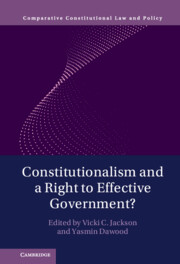Book contents
- Constitutionalism and a Right to Effective Government?
- Comparative Constitutional Law and Policy
- Constitutionalism and a Right to Effective Government?
- Copyright page
- Dedication
- Contents
- Tables
- Contributors
- Acknowledgments
- Part I Introduction
- Part II What Are Constitutions For?
- Part III Positive Rights and Rights to Effective Self-Government
- Part IV The Role of Courts in Building State Capacity and Promoting Effective Self-Government While Protecting Rights
- Part V Executive and Administrative Constitutionalism in Effective Democratic Government
- Part VI Legislatures, Representation, and Duties of Effective Self-Government
- Part VII Politics, Sociology, Media, and Corruption as Contexts for Constitutionalism and Governance
- 17 Can Constitutions Fix Party System Breakdowns?
- 18 Political Fragmentation and the Decline of Effective Government
- 19 Constitutionalism and Public Corruption
- Index
17 - Can Constitutions Fix Party System Breakdowns?
A Skeptical View
from Part VII - Politics, Sociology, Media, and Corruption as Contexts for Constitutionalism and Governance
Published online by Cambridge University Press: 20 October 2022
- Constitutionalism and a Right to Effective Government?
- Comparative Constitutional Law and Policy
- Constitutionalism and a Right to Effective Government?
- Copyright page
- Dedication
- Contents
- Tables
- Contributors
- Acknowledgments
- Part I Introduction
- Part II What Are Constitutions For?
- Part III Positive Rights and Rights to Effective Self-Government
- Part IV The Role of Courts in Building State Capacity and Promoting Effective Self-Government While Protecting Rights
- Part V Executive and Administrative Constitutionalism in Effective Democratic Government
- Part VI Legislatures, Representation, and Duties of Effective Self-Government
- Part VII Politics, Sociology, Media, and Corruption as Contexts for Constitutionalism and Governance
- 17 Can Constitutions Fix Party System Breakdowns?
- 18 Political Fragmentation and the Decline of Effective Government
- 19 Constitutionalism and Public Corruption
- Index
Summary
Parties have emerged as a central concern of comparative constitutional law, and for good reason. Parties should be at the forefront of descriptive analyses of how constitutions function. In practice, for instance, the separation of powers depends heavily on the shape of the party system, as do many other aspects of constitutional performance.1 Moreover, breakdowns of party systems have been a significant factor in explaining recent episodes of democratic erosion or breakdown.2 In other words, crises of liberal democratic constitutionalism are often caused by crises in party systems.
But what is more challenging is developing a normative theory linking constitutions and parties. In other words, to what extent can constitutions (or comparative constitutional law) prevent or fix breakdowns in party systems? On that question, this chapter offers some skepticism, or at least outlines a series of challenges.
Section 17.2 develops a brief map of the different ways in which party systems break down.
Keywords
- Type
- Chapter
- Information
- Constitutionalism and a Right to Effective Government? , pp. 223 - 234Publisher: Cambridge University PressPrint publication year: 2022

